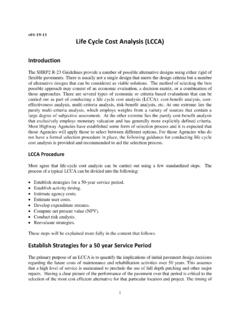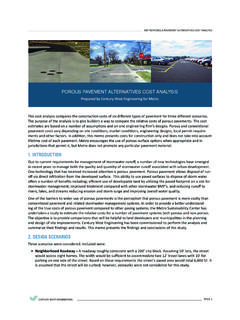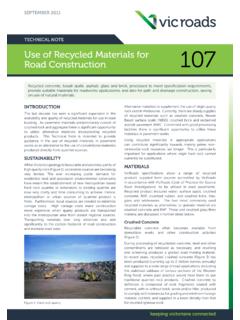Transcription of BEST PRACTICES-LONG LIFE FLEXIBLE PAVEMENT …
1 0 PAVEMENTS June 26, 2013 RECOMMENDATIONS FOR THE DESIGN AND CONSTRUCTION OF LONG LIFE FLEXIBLE PAVEMENT alternatives using existing PAVEMENTS 1 Table of Contents Topic Page Introduction 3 HMA Renewal Strategies 4 General Guiding Principles 4 HMA Overlays over existing HMA Pavements 5 Criteria for Long Life Potential 5 HMA over existing HMA and Specifications 7 HMA over Reclaimed HMA PAVEMENT 7 Criteria for Long Life Potential 7 Construction Operations 8 Quality Control 11 HMA over Reclaimed HMA PAVEMENT and Specifications 11 HMA Overlays over existing HMA-Surfaced Composite Pavements 12 HMA over Crack and Seat JPC Pavements 13 Criteria for Long Life Potential 13 HMA over Crack and Seat PCC and Specifications 15 HMA over Saw Crack and Seat JRC Pavements 16 Criteria for Long
2 Life Potential 16 HMA over Saw, Crack, Seat PCC and Specifications 19 HMA over Rubblized Concrete Pavements 19 Criteria for Long Life Potential 19 Construction Operations 20 Rubblized Concrete Size Requirements 24 Suitability for Rubblization 25 HMA over Rubblized PCC PAVEMENT and Specifications 27 HMA over CRC Pavements 27 Criteria for Long Life Potential 27 Surface Preparation/Repair and Overlay Depths 29 HMA over existing CRC PAVEMENT and Specifications 33 Added Lanes and Approaches for Adjacent Structures 33 Approaches to Undercrossings, Bridges, and Overcrossing Structures 34 Added Lanes or Widening 35 Widening Next to Rubblized PCC PAVEMENT 35 Widening Next to Crack and Seated or Saw, Crack and Seated PCC PAVEMENT 36 Structural Design Criteria to Achieve Long Life 37 Basic Approach 37 Endurance Limits 37 PAVEMENT Design Software 37 Example Designs 39 2 Topic Page HMA Mill and Fill Overlay over existing HMA PAVEMENT 39 HMA Overlay over Fractured PCC PAVEMENT 40 Minimum HMA Thicknesses 40 HMA Mix Design Criteria to Achieve Long Life 41 Surface Course 42 Binder (Intermediate)
3 Course 44 Base Course 45 HMA Stripping Causes, Assessment, Solutions 46 Introduction and Background 46 California Study 49 Tests to Predict Moisture Sensitivity 50 Component and Compatibility Tests 50 Tests on Loose Mix 50 Tests on Compacted Mix 52 Solutions Treatment Methods and Compaction 54 HMA Stripping--Recap 55 Project Evaluation 55 The Basics 55 Top-Down Cracking 58 HMA Construction Quality Control 61 HMA Density 61 HMA Segregation 62 Longitudinal Joints 64 Interlayer Bonding 65 QC Testing 65 HMA Quality Control and Specifications 65 Summary 67 References 69 3 RECOMMENDATIONS FOR THE DESIGN AND CONSTRUCTION OF LONG LIFE FLEXIBLE PAVEMENT alternatives using existing PAVEMENTS Introduction For purposes of this study, long life PAVEMENT is defined as PAVEMENT sections designed and built to last 50 years or longer without requiring major structural rehabilitation or reconstruction.
4 Only periodic surface renewal in response to distresses confined to the top of the PAVEMENT would be required. This document was developed by the study team with input from State DOTs and HMA paving contractors. The intent of the long life PAVEMENT concept is to significantly extend current PAVEMENT design life by restricting distress, such as cracking and rutting, to the PAVEMENT surface. Common distress mechanisms such as bottom-up fatigue cracking and rutting in the unbound layers should, in principle, be completely eliminated. However, surface initiated (top-down) cracking will still be possible. This type of cracking is caused by a complex combination of PAVEMENT structure, load spectra, environmental and material characteristics.
5 While its causes are still not fully resolved, this deterioration mechanism involves a fatigue-like response in the upper layers of the PAVEMENT . In addition to fatigue cracking and rutting, in cold climates, low-temperature cracking and frost heave must also be taken into account. Another deterioration mechanism that should be accounted for is aging. Aging mainly affects the top asphalt layers and is manifested by increased stiffness and decreased flexibility over time. A common denominator of the distress mechanisms mentioned above is they are difficult to model using current mechanistic-empirical methods. In the case of top-down cracking and permanent deformations in the asphalt-bound layers, new and improved design methods may address this in the future.
6 When using existing pavements, the inhibition of reflective cracking is crucial. Reflective cracking is caused by repetitive shearing, , when a new asphalt layer is laid upon an already cracked layer. With time, the crack will propagate through the new layer. This is true irrespective of the existing PAVEMENT type ( , distressed HMA or PCC), although experience shows that reflective cracking can be more predominant when the existing PAVEMENT is a PCC. Reflection cracking can occur in an HMA overlay over any joint or crack in the PCC PAVEMENT . The current state-of-the-art does not provide accurate methods to predict the occurrence and growth of the reflection crack. However, a number of approaches have been shown to minimize or eliminate these occurrences.
7 These approaches are discussed in the following sections along with a discussion of 4 those features and construction processes that are considered critical to produce long life pavements. HMA Renewal Strategies The most promising renewal strategies for long life using existing pavements are: HMA over HMA renewal methods o HMA over existing HMA PAVEMENT o HMA over reclaimed HMA (recycling) HMA over PCC renewal methods o HMA over existing HMA-surfaced composite pavements o HMA over crack and seated JPC pavements o HMA over saw, crack and seat JRC pavements o HMA over rubblized JPC pavements o HMA over existing CRC pavements Each strategy will be described in this document. General Guiding Principles The following are guiding principles for any renewal solution to achieve good performing long life pavements: Keep the renewal solution as simple as possible, but not too simple so as to not address critical underlying problems.
8 The quality of construction is essential in achieving long life pavements. Pavements are supposed to act as one layer; therefore the bond between layers should never be compromised, and a few thick layers are always better than multiple thin layers. All joints are weaknesses; therefore they need to be treated as such. Good, continuous, and sustainable drainage is essential to long life PAVEMENT ; therefore no matter how thick the renewal solution is, it can fail if drainage is not provided. Foundation uniformity is essential to reduce/eliminate stress concentrations, which can cause future cracking. A solid foundation allows good compaction; unsupported edges can never be properly compacted. Thermal movements of the existing PAVEMENT are the underlying cause for much reflective cracking; therefore they must be eliminated (by fracturing the existing PAVEMENT ).
9 5 Good performing asphalt mixtures should have high binder content and low air voids (to have high durability), and smaller nominal size (to avoid segregation). The following sections provide best practices (guidelines) for each rapid renewal strategy to achieve long life pavements based on relevant literature and agency information. HMA Overlays over existing HMA Pavements Criteria for Long Life Potential This renewal solution is viable as long as the following critical features are met: The surface condition is good and the structural capacity of the existing AC PAVEMENT is adequate for a potential long life PAVEMENT . There is no evidence of stripping in any of the existing HMA layers (determined through coring and/or GPR testing).
10 Proper repair and surface preparation is provided for the existing surface layer, and a good tack/bond coat is provided. The existing drainage system is in good working condition, or adequate drainage is provided. If there is no visible distress in the existing HMA PAVEMENT other than in isolated areas, the existing PAVEMENT can be directly overlaid as long as it is structurally sound, level, clean and capable of bonding to the overlay. Small areas of localized distresses in the existing PAVEMENT should be repaired or replaced to provide the required structural support. Milling before placing an overlay significantly aids the bond between the old and new HMA. When there is visible surface distress and it is determined that cracking is only present near the surface (through coring), the first step in the resurfacing process will be the removal of the existing surface to the depth of the cracking.






